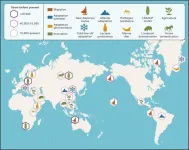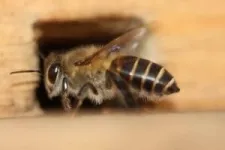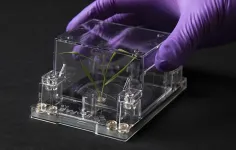(Press-News.org) Writing a commentary in the 50th anniversary issue of Cell, FU Qiaomei and E. Andrew Bennett, both of the Institute of Vertebrate Paleontology and Paleoanthropology (IVPP) of the Chinese Academy of Sciences, explored the contribution of paleogenomics to our understanding of the evolution of modern humans.
Given her numerous contributions to the field of human evolution through the analysis of both archaic and early modern human genomes, Prof. FU was invited by the journal Cell to write a commentary reviewing what we have learned about the evolution of modern human identity from ancient DNA.
The article, "Ancient genomes and the evolutionary path of modern humans," was published on Feb. 29.
The central role of human origin stories in belief systems around the world attests to humans' enduring fascination with our beginnings. Archeological and paleoanthropological findings have helped to describe the earliest appearances of the modern human form and the beginning of behaviors that set us apart from other living creatures. The sequencing of the first human genome more than 20 years ago brought the power of comparative genomics to questions about the differences between humans and great apes. But modern humans and chimpanzees, our closest living relatives, are separated by roughly six million years of evolution, making such approaches inadequate for studies closer in time to the appearance of modern human qualities.
Likewise, the 1,000 Genomes Project has allowed us to appreciate the expanse of modern human genetic diversity, but admixture and an incomplete understanding of the genetic structure of prehistoric populations have limited our exploration of deeper events using only modern genomes. The recent availability of early modern human genomic data as well as archaic genomic data from Neanderthals and Denisovans has given us the means to better trace the genetic changes underlying the origin of modern humans.
In their commentary, the authors recapped our current understanding, based on the fields of paleoanthropology and archeology, of the evolution of modern human morphology and behavior. They later summarized contributions to our understanding of "being human" from the field of paleogenomics. FU and Bennett decided to divide these contributions into two distinct approaches: a direct approach that attempts to identify modern human-specific genetic changes based on direct comparisons of modern and archaic human genome sequences, and a more indirect approach whereby researchers attempt to reconstruct the life history of archaic and early modern human populations from ancient DNA.
Their article notes that both of these investigative methods have the power to explore different aspects of emerging modern human populations; however, each has its own specific set of complications to overcome.
The sequence-based approach can theoretically identify genetic changes common to all modern humans that distinguish them from Neanderthals and Denisovans, but the utility of this approach is currently limited by our incomplete understanding of the genetic diversity of archaic and early modern human populations. For example, expanded sequencing of modern genomes from diverse parts of Africa has revealed that some alleles previously found only in archaic genomes are also present in modern populations.
In contrast, the indirect approach attempts to decipher signals left in ancient genomes that can help us better understand past behaviors and population characteristics, such as population size, family structure, and mating practices, as well as adaptation to changing climates, local pathogens, and lifestyle innovations. These details, inaccessible using previous methods, add a new dimension to our understanding of human origins.
The authors reviewed several studies and concluded that, despite the paucity of data currently available, some differences between early modern humans and archaic populations have emerged. Although both early modern human and Neanderthal populations appear to have practiced female exogamy, where female mates were chosen from outside closely related groups, early modern humans appear to have maintained greater genetic diversity than their archaic counterparts, with their immediate ancestors being more distantly related to each other.
Although no single genetic cause has been found to explain why modern human populations expanded while archaic populations contracted and disappeared, FU and Bennett discussed how several individual fitness advantages can arise from belonging to a larger and better connected population network.
Taken together, these population-level advantages, called "Allee effects" in population biology, can lead to improved success in activities such as resource exploitation, defense, and mate selection, and may have been sufficient to explain the different outcomes of early modern and archaic human populations. The commentary also points out that despite this success, much genomic diversity has also been lost along the way, and ancient DNA studies have identified several distinct modern human populations in the past that have left no descendants among present-day humans.
Ancient genetic data has also helped to describe the origin of human adaptation to local environments, such as the EDAR variant that appeared in northern East Asia during the last Ice Age, or the likely introgression of the EPAS1 allele from Denisovans, which aids survival at high altitudes. Similar adaptations to local diets and pathogens have been documented, as have adaptations to new innovations, such as lactase persistence after cattle domestication. The increased mobility and adaptability of modern human populations since they left Africa has ensured that much ancient genomic data remains to be discovered and studied.
By integrating the latest findings from ancient DNA with those emerging from paleoanthropology and archeology, FU and Bennett's commentary has expanded and updated the discussion of human origins.
END
Becoming human: An ancient genome perspective
2024-02-29
ELSE PRESS RELEASES FROM THIS DATE:
Extreme weather events tied to increased mortality and emergency department activity
2024-02-29
Climate change is increasing the frequency and intensity of severe weather events, which may particularly endanger vulnerable populations such as the elderly. Researchers from Mass General Brigham and colleagues examined how weather disasters between 2011 and 2016 influenced healthcare delivery and mortality among Medicare beneficiaries in affected counties, finding that one week after major weather events, emergency department (ED) use and mortality remained elevated by 1.22% and 1.4%, respectively, from pre-disaster ...
Bottlenecks and beehives: how an invasive bee colony defied genetic expectations
2024-02-29
For more than a decade, invasive Asian honeybees have defied evolutionary expectations and established a thriving population in North Queensland, much to the annoyance of the honey industry and biosecurity officials.
Research published today in Current Biology has shown the species, Apis cerana, has overcome what is known as a genetic bottleneck to grow from a single swarm into a population of more than 10,000 colonies over a 10,000 square kilometre area – which is about the size of Greater Sydney.
Co-lead author Dr Rosalyn Gloag from the University of Sydney School of Life and Environmental Sciences said: “Our study of this bee population shows that some species can ...
Climate: 2023 – 24 El Niño likely to cause record-breaking average temperatures in some areas
2024-02-29
Several areas of the globe — including the Bay of Bengal, the Philippines, and the Caribbean Sea — are likely to experience record-breaking average surface air temperatures in the year period up to June 2024 as a result of the ongoing El Niño phenomenon. The modelling results, published in Scientific Reports, also suggest that there is an estimated 90 percent chance of record-breaking global mean surface temperatures occurring over the same period under a moderate or strong El Niño scenario.
The El Niño-Southern Oscillation, centred ...
Disparities in patient portal use among adults with chronic conditions
2024-02-29
About The Study: This study of 536 participants identified changes in patient portal use over time and highlighted populations that had lower access to health information. The COVID-19 pandemic was associated with an increase in portal use. Sociodemographic disparities by sex and age were reduced, although disparities by health literacy widened. A brief validated health literacy measure may serve as a useful digital literacy screening tool to identify patients who need further support.
Authors: Esther Yoon, Ph.D., M.P.H., M.S., of Northwestern University in Chicago, is the corresponding ...
Factors associated with racial and ethnic disparities in locally advanced rectal cancer outcomes
2024-02-29
About The Study: The findings of this study of 34,500 patients suggest that racial and ethnic disparities in locally advanced rectal cancer treatment outcomes may be multifactorial, with an independent association with non-Hispanic Black race, suggesting unidentified biological variables or social determinants of health that warrant exploration.
Authors: Sanjeevani Arora, Ph.D., and Shannon M. Lynch, Ph.D., M.P.H., of the Fox Chase Cancer Center in Philadelphia, are the corresponding authors.
To access the embargoed study: Visit our For The Media website at this link https://media.jamanetwork.com/
(doi:10.1001/jamanetworkopen.2024.0044)
Editor’s ...
CZI announces multi-institutional collaborations for tech to better understand cells
2024-02-29
Today, the Chan Zuckerberg Initiative (CZI) announced four multi-year grants that will bring together regional labs in California, the Mid-Atlantic, and the Research Triangle in North Carolina to explore the frontiers of genomics, cell biology, and synthetic biology by developing new measurement technologies. These projects will focus on developing technologies to engineer cell and tissue models, exploring cellular responses to genetic and environmental stressors, understanding RNA's role in metabolism, and more.
“To unravel the mysteries of the cell, we need new technologies, and the Exploratory Cell Networks grants support early-stage ...
Researchers uncover key therapeutic target involved in diabetic atherosclerosis
2024-02-29
Diabetes accelerates the development of atherosclerosis, increasing the incidence of cardiovascular events. In atherosclerosis, immune cells called macrophages release molecules such as chemokines and cytokines, causing inflammation and leading to arterial plaque formation. However, significant gaps persist in understanding the exact molecular mechanisms controlling this increased inflammatory response in individuals with diabetes. In a new, preclinical study, researchers from Brigham and Women’s Hospital, a founding member of the Mass General Brigham healthcare system, identified a long non-coding RNA (lncRNA) sequence that could help them unravel the ...
Scripps Research scientists reveal how first cells could have formed on Earth
2024-02-29
LA JOLLA, CA—Roughly 4 billion years ago, Earth was developing conditions suitable for life. Origin-of-life scientists often wonder if the type of chemistry found on the early Earth was similar to what life requires today. They know that spherical collections of fats, called protocells, were the precursor to cells during this emergence of life. But how did simple protocells first arise and diversify to eventually lead to life on Earth?
Now, Scripps Research scientists have discovered one plausible pathway for how protocells may have first formed and chemically ...
EcoFABs could lead to better bioenergy crops
2024-02-29
– By Will Ferguson
A greater understanding of how plants and microbes work together to store vast amounts of atmospheric carbon in the soil will help in the design of better bioenergy crops for the fight against climate change.
Deciphering the mechanics of this mutually beneficial relationship is challenging, however, as conditions in nature are extremely difficult for scientists to replicate in the laboratory. To address this challenge, researchers at Lawrence Berkeley National Laboratory (Berkeley Lab) created fabricated ecosystems or EcoFABs.
In a new paper in Science Advances, they ...
Digital Science announces Catalyst Grant winners, supporting AI-based innovations to benefit research
2024-02-29
Digital Science has awarded two new Catalyst Grants of £25,000 each to innovative AI-based technology ideas aimed at advancing global research.
The winners will use the funding to develop their ideas, which include using AI to alleviate the burden on researchers of applying for research funding, and to predict research impact.
The winning applications from Digital Science’s 2023 Catalyst Grant round announced today are:
Atom – Tomer du Sautoy (co-founder and CEO) and Hamilton Evans (co-founder and ...






